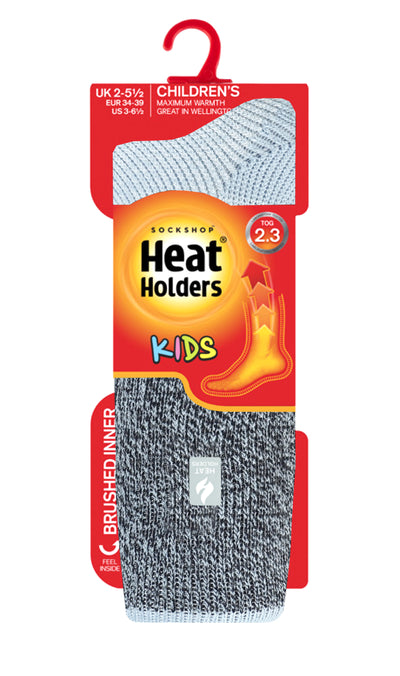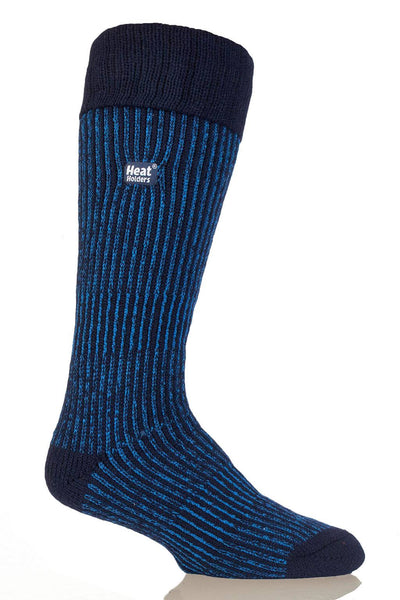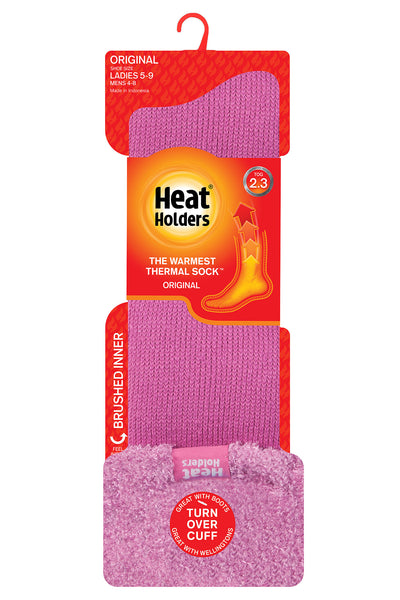Winter weather can be harsh, and one of the most important things to protect during this season is our feet. Cold feet can not only be uncomfortable, but they can also lead to various health risks. To keep your feet warm and cozy this winter, it's essential to invest in the right socks. In this ultimate guide, we will explore the science behind cold feet and the best socks available on the market to keep your feet toasty warm.
Understanding the Importance of Warm Feet in Winter
Before we dive into the world of winter socks, let's first understand why warm feet are crucial during the winter months. When our feet get cold, our blood vessels constrict to conserve heat. This can lead to reduced blood flow and lower core body temperature. Cold feet can also cause discomfort, numbness, and even foot ailments.
Imagine walking through a winter wonderland, snowflakes gently falling around you. The crisp air fills your lungs as you take each step, but suddenly, you feel a chill creeping up from your toes. Your feet, once warm and cozy, now feel like blocks of ice. You start to notice the discomfort, the tingling sensation, and the numbness that slowly spreads. It's not just a matter of inconvenience; it's a matter of health.
The Science Behind Cold Feet
Cold feet occur due to the body's natural thermoregulation process. When the temperature drops, our body prioritizes keeping our vital organs warm, resulting in colder extremities like our feet. Understanding this process can help us choose the right socks to combat cold feet effectively.
Our bodies are remarkable machines, constantly working to maintain a stable internal temperature. When exposed to cold temperatures, our blood vessels in the extremities constrict, reducing blood flow to these areas. This constriction is a protective mechanism, as it helps to conserve heat and redirect it to our vital organs. However, this process can leave our feet vulnerable to the icy grip of winter.
As the blood vessels constrict, less warm blood reaches our feet, leading to a decrease in temperature. The lack of blood flow can cause our feet to feel cold, and if left untreated, it can lead to more serious consequences.
Health Risks Associated with Cold Feet
While cold feet may seem like a minor inconvenience, they can lead to serious health risks. Prolonged exposure to cold temperatures can increase the chances of frostbite and hypothermia. Frostbite occurs when the tissues in our extremities freeze, leading to cell damage and potential amputation if not treated promptly.
Imagine the beauty of a winter landscape, the snow-covered trees glistening in the sunlight. It's a sight to behold, but when your feet are exposed to frigid temperatures for an extended period, that beauty can quickly turn into a nightmare. Frostbite can sneak up on you, starting with a mild tingling sensation and progressing to numbness and discoloration. It's a painful reminder of the importance of keeping our feet warm.
Cold feet can also aggravate circulatory issues like Raynaud's disease, a condition characterized by the narrowing of blood vessels in response to cold or stress. This can lead to painful episodes of color changes in the skin, ranging from white to blue to red. Additionally, individuals with poor circulation may experience an increased risk of foot conditions such as chilblains and athlete's foot.
Chilblains, also known as pernio, are painful and itchy red or purple bumps that develop on the skin when exposed to cold temperatures. They can cause discomfort and may take weeks to heal. Athlete's foot, on the other hand, is a fungal infection that thrives in warm and moist environments, making cold feet more susceptible to its development.
So, as we venture into the realm of winter socks, let us not forget the importance of warm feet. It's not just about comfort; it's about safeguarding our health and well-being in the face of winter's icy embrace.

The Anatomy of a Winter Sock
Now that we've covered the importance of warm feet, let's take a closer look at the anatomy of a winter sock. Understanding the different materials, thicknesses, and layering techniques will help us choose the best socks to keep our feet warm in winter.
Winter socks are designed with the specific purpose of providing warmth and comfort during the colder months. They are crafted using a combination of materials, each with its unique properties that contribute to the overall functionality of the sock.
Material Matters: Wool, Cotton, and Synthetics
When it comes to warmth, wool is the go-to material for winter socks.
Wool has excellent insulating properties and can effectively wick away moisture, keeping your feet dry and warm. The natural fibers of wool create tiny air pockets that trap heat, providing an extra layer of insulation against the cold. Additionally, wool can retain its insulating properties even when wet, making it ideal for winter activities where your feet may come into contact with snow or slush.
Cotton, on the other hand, tends to retain moisture, making it less suitable for winter wear. While cotton may be comfortable and breathable, it does not provide the same level of insulation as wool. Cotton socks can become damp from sweat, which can lead to cold and uncomfortable feet in colder temperatures.
Synthetics like nylon and polyester can provide durability and moisture-wicking capabilities and using proprietary manufacturing processes, these advanced thermal yarns can be as much as 7X warmer than the average cotton sock.
The Role of Thickness and Layering
Choosing the right thickness and layering technique for your winter socks is crucial. Thicker socks with multiple layers create a better barrier against the cold. The additional layers help to trap more warm air around your feet, providing increased insulation. However, it's important to ensure that the socks fit comfortably in your shoes without constricting blood flow. Tight socks can restrict circulation, leading to cold feet and potential discomfort.
When considering the activity level and temperature, it's essential to choose the appropriate sock thickness. If you're engaging in high-intensity activities like skiing or snowboarding, thicker socks may be necessary to provide extra cushioning and insulation. On the other hand, if you're going for a leisurely winter walk, a medium-thickness sock may be sufficient to keep your feet warm without causing overheating.
Layering socks can also be an effective way to enhance insulation. By wearing a thin moisture-wicking liner sock underneath a thicker wool sock, you create a double layer of insulation. This layering technique helps to trap warm air and wick away moisture, keeping your feet dry and comfortable throughout the day.
It's worth noting that the fit of your winter socks is just as important as their materials and thickness. Socks that are too tight can restrict circulation, while socks that are too loose may cause friction and blisters. Opt for socks that provide a snug, yet comfortable fit, allowing for proper blood flow and preventing any discomfort during winter activities.
Top Features to Look for in Winter Socks
Now that we understand the anatomy of winter socks, let's explore the top features to look for when selecting the perfect pair to keep your feet warm during the winter season.
Winter is a season that demands extra care and attention, especially when it comes to keeping our extremities warm. Our feet, being the farthest from our core, are particularly vulnerable to the cold. That's why investing in high-quality winter socks is crucial to ensure optimal comfort and protection.
Insulation and Warmth
The primary function of a winter sock is to provide insulation and retain body heat. Look for socks with a high wool percentage or advanced insulation technologies that can trap warmth and prevent heat loss. Wool, a natural insulator, has excellent thermal properties that can keep your feet cozy even in the harshest winter conditions. Additionally, consider socks with additional padding or cushioning to provide added comfort and insulation, making each step feel like walking on a cloud.
When it comes to insulation, it's important to strike a balance. While you want your socks to keep you warm, you also don't want them to be too thick, as this can lead to sweaty feet and discomfort. Opt for socks that offer the perfect combination of warmth and breathability.
Moisture Wicking Capabilities
Moisture-wicking capabilities are crucial in winter socks to keep your feet dry. When we're active, our feet tend to sweat, and if that moisture is not effectively managed, it can lead to cold and clammy feet, which can be quite uncomfortable.
Look for socks with moisture-wicking properties to prevent sweat build-up. Materials like merino wool are known for their excellent moisture-wicking abilities, allowing your feet to stay dry and comfortable throughout the day.
Moreover, socks with antimicrobial properties can help combat odor-causing bacteria, ensuring that your feet stay fresh and odor-free even after hours of wear.
Comfort and Fit
A comfortable and well-fitting sock is essential for all-day warmth. Look for socks with features like seamless toes to prevent irritation and blisters. The last thing you want during the winter season is to deal with painful blisters that can make every step a struggle. Seamless toes eliminate the risk of friction and irritation, providing a smooth and comfortable fit.
Ensure that the socks have enough stretch and a snug fit without being too tight, as tight socks can restrict blood flow and cause discomfort. Look for socks with a good elasticity that can comfortably hug your feet without feeling constricting.
Lastly, consider the height of the socks. Winter socks come in various lengths, from ankle to knee-high. The height you choose depends on your personal preference and the level of warmth and coverage you desire. Knee-high socks, for example, provide additional insulation for your lower legs and can be a great option for outdoor activities in extremely cold conditions.
Reviewing the Best Winter Socks on the Market
Now that we know what to look for in winter socks, let's review some of the best options available on the market. Whether you're looking for high-end socks for extreme cold or budget-friendly options for milder winter weather, we've got you covered.
High-End Winter Socks for Extreme Cold
-
Blended Merino Wool - With a blend of merino wool and advanced insulation technology, these socks provide exceptional warmth and moisture-wicking capabilities.
-
Joshua Original - Made with a mix of synthetic materials, these socks offer durability and moisture management for extreme cold weather conditions.
- Worxx - Designed with a reinforced toe and heel, these socks provide maximum insulation and comfort for extreme cold adventures.
Budget-Friendly Socks for Mild Winter Weather
-
Mason Lite - These affordable socks made from a wool blend offer great value for money and adequate warmth for mild winter days.
-
Mavrick Lite - With a focus on moisture-wicking, these socks keep your feet dry and comfortable during light winter activities.
- Ankle socks - Designed with a comfortable fit and lightweight material, these socks are perfect for everyday wear during milder winter conditions.
Proper Care and Maintenance for Your Winter Socks
Lastly, let's discuss how to care for and maintain your winter socks. By following proper cleaning and storage guidelines, you can extend the lifespan of your socks and ensure optimal warmth throughout the winter season.
Washing and Drying Guidelines
To keep your winter socks performing at their best, it's important to adhere to washing and drying guidelines. Follow the manufacturer's instructions, but in general, it's recommended to hand wash wool socks using a mild detergent and air dry them to maintain their shape and insulation properties.
Conclusion
Choosing the right socks is key to keeping your feet warm and comfortable during the winter months. With a wide range of materials, thicknesses, and features available, finding the perfect pair can be an enjoyable process. Remember to prioritize insulation, moisture-wicking capabilities, comfort, and fit when selecting your winter socks. Proper care and maintenance will also ensure their longevity. Stay warm and cozy this winter with the best socks for winter weather.















